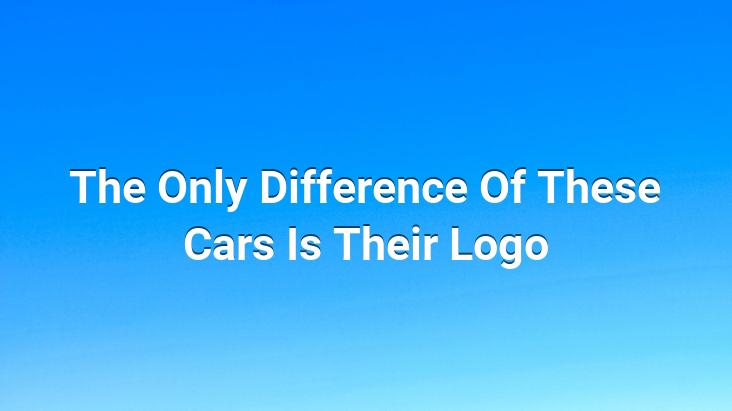Things weren’t going so well in the world in 1917. While the First World War was wreaking havoc, someone was trying to get on with their work.. The executives of the American automaker Texan needed to find a solution to overcome this situation.. Then the company signed a first in automotive history. Texas-based Texan made an agreement with the Elcar brand, which produces in Elkhart, Indiana, and sold it by putting its own logo on the cars produced there.. Thus, Texan became the first automotive brand to engineer a logo.. After that day, many brands in the sector came together and developed a car together.. Then they put their own brand logo on this car and put it on the market.. Recently, this old habit has started to become popular again in the automotive industry.. The automotive industry, which had a very difficult time after 2008, is trying to find a way to contain its costs by mixing old books.. The streets are starting to fill up with twin or even triple cars that look alike but have different logos.. In this process, they need to keep the industry’s costs under control while not harming their brands.. Things have not been going well for a while in Europe, one of the world’s most important markets.. The serious contraction in automobile sales, especially in Southern Europe, has had a very bad effect on brands such as Fiat, Peugeot and Citroen.. Companies such as Fiat, PSA Group, Ford had to close many production facilities in Europe and lay off many employees.. As a matter of fact, Fiat CEO and European Automobile Manufacturers Association President Sergio Marchionne, who made a statement to the press in the past months, said, “After the downward trend in the last five years, many of the automotive manufacturers are making losses in Europe these days.. The current picture is far from optimistic.. We expect the market to shrink by 8 to 10 percent in 2012 compared to 2011. The situation is quite vital for many manufacturers trying to maintain the same production capacities as before the crisis,’ he says.
As a matter of fact, Volvo Car Group Vice President of Sales Operations Alain Visser also states that they do not foresee growth in the European market for the next year.. However, his painting is not as pessimistic as Marchionne.
One of the biggest problems at the beginning of the automotive industry too much capacity. In the current picture, automotive companies are looking for solutions to both utilize excess capacity more effectively and reduce their costs.. Platform sharing is the most popular of these solutions.. Many brands reduce production costs by developing different models on common platforms.. In particular, brands that include many brands such as Volkswagen Group develop their different brands on a common platform.. They even use common models and components. Volkswagen Polo, Skoda Fabia, Seat Ibiza, three of the Volkswagen brands produced on the common platform. Again, Volkswagen Touareg, Audi Q7 vs Porsche Cayenne are cars produced on the same platform.. Hyundai shares such common platforms with Kia, Peugeot Citroen and Renault with Nissan, and Fiat with Chrysler.. Apart from its own brand group, many brands develop models using a common platform.. Mazda and Ford developed Mazda 2 and Ford Fiesta on the same platform for a while. envisioned. Global production of passenger cars and light trucks of 17 million by the top 10 major platforms in 2010 is expected to reach 33 million by 2020, an increase of 94 percent.. By 2020, the Daimler, Volkswagen and Fiat-Chrysler groups are expected to shrink their platforms by 60-65%, respectively.. Production volume per platform expected to quadruple by 2020 compared to 2010. In total, the average vehicle production per platform will increase threefold in 2020 compared to 2010 and will reach 240 thousand units.. Nine of the top 10 platforms are expected to reach at least two million annual unit volumes and triple their volumes in 2020 compared to the top three platforms in 2010.
Another of the most important cost factors for automotive manufacturers is the engine.. That’s why many brands are developing a common engine outside of the platform.. Group brands often use the same engines. Kia, Hyundai and Peugeot always use common engines in equivalent models with Citroen.. In addition, some of Ford’s diesel models used Peugeot’s diesel engine, while Opel used Fiat’s Multijet engine in some of its cars.. Renault’s 1.5-liter diesel engine is used in the diesel models of Mercedes’ A series, which are now on the market.. In return, Mercedes will give Renault one of its bigger engines.. Although there is no clear explanation for now, it may be possible to use this engine in a new model of Infiniti, one of the Renault Nissan Group brands.
All these partnerships are not new to the automotive industry.. However, the situation for the sector has reached such a level that even these measures are not enough to bring the costs to the desired levels.. For this reason, brands have started to take the measures one step further.. Now, beyond using a common platform and engine, companies develop joint cars. In the same factories, they develop twins or even triplets of each other with very slight differentiations.. They call it logo engineering.. This method has been seen frequently in the industry recently.. One of the pioneers of logo engineering in Turkey Tofaş. The company owns Fiat Fiorino, which has been produced since 1997.. started to produce its generation under the code name Mini Cargo for both Fiat, Citroen and Peugeot in 2007.. Mini Cargo produced in Bursa is sold with the Peugeot Bipper logo at Peugeot dealers, Citroen Nemo at Citroen dealers and Fiat Bipper at Fiat dealers.. Also in Bursa, Tofaş started to produce the Opel Combo as the twin of Fiat Doblo last year.
This logo engineering is not a Turkey-specific method. Mercedes’ light commercial model Citan, which was introduced to the market recently, is produced in Renault factories in France as the twin sister of Renault Kangoo.. Citroen C-Elysee and Peugeot 301, Toyota GT86 and Subaru BRZ are the first models that come to mind when twin cars are mentioned.
Although logo engineering, whose examples have been increasing in recent years, has been frequently confused with platform sharing, which has been applied frequently until now, these two are a different process from each other.. The cars are almost identical, except for minor differences in logo engineering.. The only difference logos. Of course, in some cases, the difference is not limited to the logo.. This difference is also reflected in the price.. If the brand of one of the brothers is positioned higher than the other, the prices naturally change with the logo attached to the car.. Mercedes Citan with Renault Kangoo, Volkswagen Up with Skoda Citigo! Twin cars are the first to come to mind when it comes to brothers that differ in price.
Actually, this is the automotive industry’s It’s like a family who can’t have a child, finally decides to do IVF.. Because the IVF method is quite expensive, doctors place multiple embryos to increase the chance of pregnancy.. As a result, the probability of having twins or even triplets increases during pregnancy.. The automotive industry is also turning to twins or even triplets to keep brands alive and to reduce risks in this expensive model creation process.
This method is really a serious problem for many brands. provides a cost advantage. However, just as twins and triplets coming with the in vitro fertilization method have financial burdens, the automotive industry also takes some risks with this method.. In particular, the risk of losing reputation of brands in front of their customers should not be ignored.. Alain Visser: ‘It’s a strange strategy to set a new price just by changing the logo and branding. All brands are doing everything they can to reduce engineering costs.. I don’t think the twin car strategy is the right strategy.. It is not a strategy that is honest with customers.’
There are also executives who do not agree with Alain Visser on this issue. İlkim Sancaktaroğlu, Deputy General Manager of Nissan Turkey, said, “Due to the crisis, automotive manufacturers have to make twin or triplet cars.. I don’t think this will cause a problem on the consumer side either.. Here, the customer is giving money to the brand for its second-hand value.”. Even though the cars are the same, the brand difference comes into play.. Factors such as the brand’s after-service services and the loss of value of the car in the second hand make some brands stand out from others even with the same car.. Minister of Science, Industry and Technology Nihat Ergün also emphasizes the importance of the brand and said, “Now, brands have come to such a position that they put their own brand in someone else’s design and sell it.. Moreover, even the cases of these cars are the same.. That’s why the brand is very important.
As Nihat Ergün said, the brand is very important for companies.. In these difficult days, companies are trying to protect and keep their brands alive at the expense of harming their brands.. They are going through a difficult path where very fine balances must be maintained.. Here, automotive manufacturers who do not pay attention to these fine lines have the risk of getting their brands hurt after the crisis.
Note: This article was written on November 16, 2012. taken. So some information may not be up to date. For example, İlkim Sancaktaroğlu does not currently continue his duty at Nissan.







